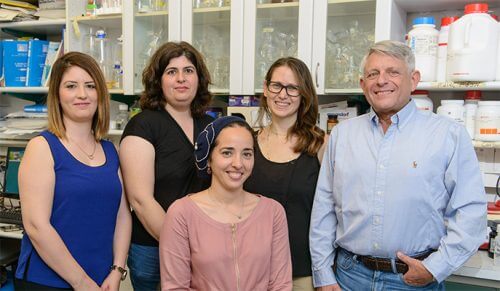Prof. Bayer and his research colleagues discovered and isolated the cellulosome for the first time in 1983, when they studied a bacterium found in nature that breaks down cellulose from plant material. The research, which continued for years, showed that the cellulosome is unlike any other system in nature, and is characteristic of a wide variety of bacteria, the common denominator of which is the ability to break down cellulose

Humans and cows do feed on different foods, but New research Discovers that, despite the evolutionary distance between them, humans share in common with cows a submicron particle involved in the digestion of food. The scientific community calls it "cellulosome". This particle, which is produced in nature by a line of cellulosic bacteria, is actually a protein complex located on the surface of these bacteria, and is common in our digestive systems - just like in the digestive systems of cows. The cellulosome is able to break down the cellulose, which is the main component of the plant wall, the same wall on which animals live (like cows) and which humans feed on every day. Cellulose is a sugar polymer that is difficult to break down, and as long as it is not broken down, it is high in energy that is not available. A new study, carried out Prof. Ed Bayer and the members of his group from the Department of Biomolecular Sciences at the Weizmann Institute of Science, in collaboration with his colleague, Prof. Raphael Lemmed from Tel Aviv University, suggested that the breakdown of cellulose - which is carried out by the bacteria of the digestive system - may have consequences for human health, including a possible connection to the phenomenon of obesity, metabolic disorders, and even disease diabetes.
Prof. Bayer and his research colleagues discovered and isolated the cellulosome for the first time in 1983, when they studied a bacterium found in nature that breaks down cellulose from plant material. The research, which continued for years, showed that the cellulosome is unlike any other system in nature, and is characteristic of a wide variety of bacteria, the common denominator of which is the ability to break down cellulose. The uniqueness of the cellulosome is in the form of the organization of dozens of cellulosic enzymes into a huge coupling, in a way reminiscent of the Lego blocks of our childhood. At the heart of the Lego-like structure is a string-like protein, to which many cellulolytic enzymes bind in a precise and orderly manner. The enzymes, which are attached to the string in a spatially orderly manner, are responsible for breaking down the cellulose fibers - which cannot be digested - into high-energy soluble sugars. The decomposition products benefit the cellulosic bacteria, other parasitic bacteria, which are not cellulosic, and also herbivores, in whose stomachs cellulosic bacteria reside.
"The new discovery concerning cellulose in humans actually began with research concerning cows," says Prof. Bayer. As part of a collaboration with Prof. Harry Flint from the University of Aberdeen, UK, he studies cellulosomes located on the walls of bacteria residing in the rump of cows. These bacteria are the main and most important factor in digesting food such as straw and plant remains: they break down the cellulose, which consists of a chain of sugars that are difficult to structure and dissolve, into available and energy-rich soluble sugars. The research of the group from Aberdeen showed that the cellulosomes of the gut bacteria are built in a basic pattern, similar to the cellulosome of arthrocellular bacteria in nature.
Later, Prof. Bayer and his research colleagues were able to find cellulosomes in bacteria that live in the small intestine of the human body. A large multinational team of scientists - including Prof. Bayer, Dr. Sarah Morais, post-doctoral researcher Dr. Barkat Desa, and research student Yonit Ben David from the Institute, in collaboration with Prof. Flint and Prof. Lamed; Dr. Ilya Borobok from Tel Aviv University; Dr. Nicole Kuroftkin and Prof. Eric Mertens from the University of Michigan Medical School, and Dr. Ennick Bernalier-Dondier from INRA, France - worked on sequencing the genome of the small intestine bacteria. At the beginning of the study, the results were not unequivocal. In the genome of that bacterium, several genes characteristic of cellulosomal components were found, but the number of genes was too low to assemble a perfect cellulosome, which is a "cellulose-eating machine". On the other hand, a deeper examination revealed that some segments of the genome were not decoded correctly. This is how the scientists discovered that these bacteria, which are found in the human intestine, indeed carry cellulosomes. In a parallel study, Prof. Bayer and his research partners discovered another cellulose-carrying bacterium found in the human microbiome, but instead of cellulose, this bacterium breaks down starch molecules.
These cellulosomes, like the bacteria that carry them, are very close to their counterparts in the cow's stomach. Prof. Bayer believes that the reason for the existence of similar bacteria in such different digestive systems is not the need to break down cellulose for nutritional purposes. In his opinion, these cellulosomes have a protective role - that is, preventing damage to the soft tissue of our digestive system, which can be caused by microscopic cellulose fibers common in plant foods. In addition, it seems that, like other intestinal bacteria, they also affect the metabolism in a person in a way that is not completely understood, and thus they may affect the tendency to obesity, a cluster of metabolic disorders, and the chance of getting diabetes.
